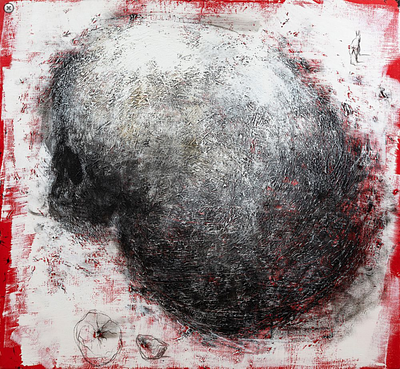MODEST CUIXART I TÀPIES (Barcelona, 1925 - Palafrugell, Girona, 2007). "Ratacat", 1962. Oil, collage and encaustic on canvas. Attached certificate
Lot 94
About Seller
Setdart Auction House
Carrer Aragó 346
Barcelona
Spain
Setdart Subastas was born in 2004 and is currently the first online art auction in Spain with solidity, prestige and reliability guaranteed by our more than 60,000 users. Setdart has a young, dynamic and enterprising team ready to successfully manage the purchase and sale of art works through custom...Read more
Estimate:
EUR€5,000 - EUR€6,000
$5,208.33 - $6,250
Absentee vs Live bid
Two ways to bid:
- Leave a max absentee bid and the platform will bid on your behalf up to your maximum bid during the live auction.
- Bid live during the auction and your bids will be submitted real-time to the auctioneer.
Bid Increments
| Price | Bid Increment |
|---|---|
| EUR€0 | EUR€10 |
| EUR€200 | EUR€25 |
| EUR€500 | EUR€50 |
| EUR€1,000 | EUR€100 |
| EUR€3,000 | EUR€200 |
| EUR€5,000 | EUR€500 |
| EUR€10,000 | EUR€1,000 |
| EUR€20,000 | EUR€2,000 |
| EUR€50,000 | EUR€5,000 |
About Auction
By Setdart Auction House
Oct 19, 2021
Set Reminder
2021-10-19 08:00:00
2021-10-19 08:00:00
America/New_York
Bidsquare
Bidsquare : CONTEMPORARY ART
https://www.bidsquare.com/auctions/setdart-auction-house/contemporary-art-7701
Setdart Auction House sofia@setdart.com
Setdart Auction House sofia@setdart.com
- Lot Description
MODEST CUIXART I TÀPIES (Barcelona, 1925 - Palafrugell, Girona, 2007). "Ratacat", 1962. Oil, collage and encaustic on canvas. Attached certificate issued by Notar S.A. in 1988. Work exhibited in the exhibition: Modest Cuixart; The Crucial Years 1955-1966. Juan March Foundation, Mallorca, 2020. Work reproduced in the catalogue of the Fundación Juan March Mallorca. With the label of the René Métras Gallery on the back. Provenance: Brok Gallery. Signed, dated and located on the back. Measurements: 82 x 69 cm. This work denotes the contemporaneity of which Cuixart was a part, despite belonging to a Spain dominated by Francoism. Both the aesthetic language and the use of the encaustic technique show us the artist's knowledge of the great currents of the time. He applied to his work the precepts of Informalism that were being developed in France and his mastery of the encaustic technique that was being popularised by the American artist Jasper Johns. As the Juan March Foundation rightly points out, "From 1958 onwards, (Cuixart) resorted to his characteristic dripping of metallic iridescence on dark backgrounds, which evolved into a kind of spatialism. At the beginning of the 1960s, the material and textural elements of Lyon's Informalism hybridised with the magicist and sign-like graphics of Dau al Set. His plastic preoccupation with the human condition meant that his interest in matter was progressively replaced by an intense irruption of the existential". Cuixart initially studied medicine, but soon abandoned his studies to devote himself to painting, and entered the Academia Libre de Pintura in Barcelona. In 1948 he took part in the founding of the group Dau al Set, together with Brossa, Ponç, Tàpies and Tharrats, among others. Concerned with the plastic value of the sign, his work has from the beginning a strong kinship with surrealism, as well as a great sensitivity towards the expressive power of colour. Towards 1955 he immersed himself in material informalism, which led him to use "grattage" in works with a certain orientalist flavour. In 1959 he won first prize at the São Paulo Biennial and exhibited at the Documenta in Kassel, and the following year he took part in an exhibition of Spanish avant-garde works at the Tate Gallery in London and the Guggenheim Museum in New York. Cuixart introduced collage into his work in 1962, which gradually led him towards pop art. Enriched by all these experiences, he returned to flat painting, achieving a very personal critical realism, which synthesises expressionism with dramatically transformed figuration, always valuing chromatic qualities. In the seventies he exhibited in numerous national and international capitals, such as Paris, Madrid, São Paulo, Amsterdam, Tokyo, Basel, Barcelona and Milan, among others. In the following decade, Cuixart gradually freed his painting from its aggressive aspects to give it a more lyrical tone. He also took part in a group exhibition at the Palais de l'UNESCO in Paris, was awarded the Cross of Saint George by the Generalitat de Catalunya and the Cross of Isabella the Catholic. In 1988 he holds an anthological exhibition in Japan, in the cities of Kobe and Tokyo. He continues to work with exuberant colours and forms, and reincorporates a more material figuration into his work. In 1998 the foundation named after him was created in Palafrugell, and the following year he was awarded the Gold Medal for Merit in Fine Arts by the Ministry of Culture. He is represented in the Museo Nacional Centro de Arte Reina Sofía, the Tate Gallery in London, the Museo Nacional de Arte de Cataluña, the Contemporary Art Museums of Madrid, Barcelona and Saint-Etienne (France), the Patio Herreriano in Valladolid, the Museo de Grabado Español Contemporáneo in Marbella, the Museo de Arte de la Universidad de São Paulo, the Museo de Arte Abstracto in Cuenca and the Museo del Ampurdán, among many others.
- Shipping Info
-
In-house shipping available. Please inquire at admin@setdart.com.
-
- Buyer's Premium



 EUR
EUR CAD
CAD AUD
AUD GBP
GBP MXN
MXN HKD
HKD CNY
CNY MYR
MYR SEK
SEK SGD
SGD CHF
CHF THB
THB
















